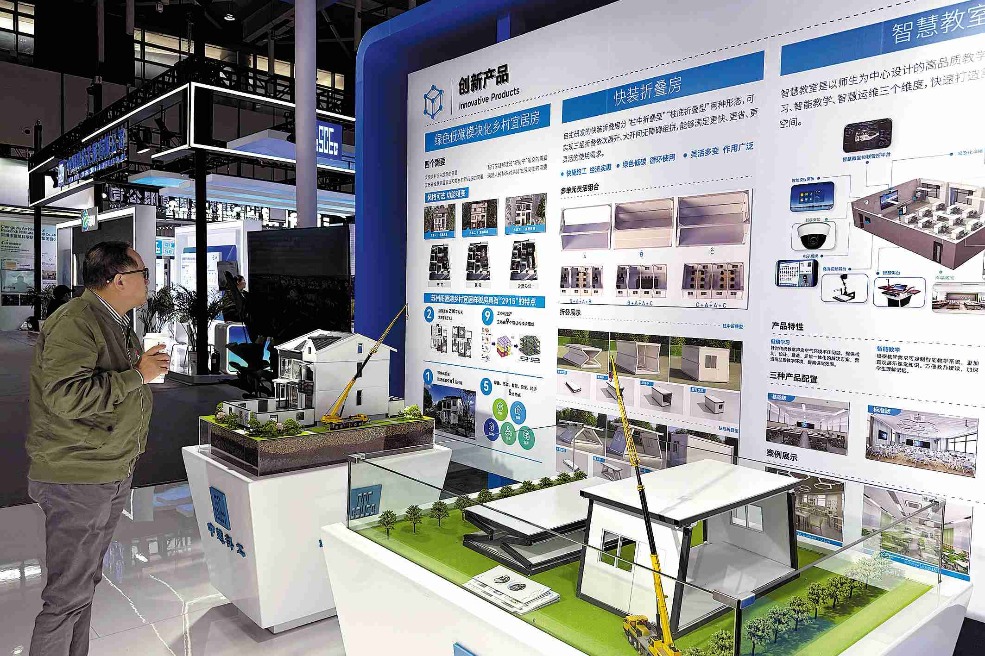Businesses use tariff pause to pivot
Return of US market largely attributed to China's hardline stance, resolute countermeasures, hard-to-replace supply chain

At 3:03 pm on May 12, Ye Zhengyang's phone buzzed with a notification that made him pause mid-sentence in a meeting. The update, shared by a client in Beijing, confirmed that China and the United States had agreed to suspend most tariffs for 90 days.
Within seconds, Ye, a 42-year-old export manager at a Ningbo, Zhejiang province-based electronics supplier, forwarded the news to his WeChat Moments feed, exhaled deeply and lit a cigarette. "It felt like the first breath of air after being underwater for months," he said.
For Ye and tens of thousands of Chinese exporters, the announcement marked the start of a race against the clock. By 4:30 pm, his team had mobilized: suppliers were ordered to ramp up production, logistics partners were pressed to prioritize shipments, and overtime shifts were extended at factories.
"Our US customers are exhibiting a greater sense of urgency in sourcing goods than us to maximize their purchases," Ye explained. "Every hour counts now. We need to move as much as possible before this window closes."
The temporary truce, stemming from recent trade talks between Washington and Beijing, offers a reprieve for exporters caught in the crossfire of tariffs that squeezed profit margins and disrupted supply chains.
According to a joint statement released on May 12 by the world's two largest economies after a high-level meeting held in Geneva, the US agreed to slash its 145 percent tariffs on Chinese imports to 30 percent, while China agreed to lower its tariffs on US goods to 10 percent from 125 percent.
Though the current tariff level is still far from business-friendly, exporters, importers and consumers are able to share the burden of the tariffs, paving the way for at least a short-term recovery in overall trade activity, executives said.
The outcome of last week's trade talks reflects a significant departure from the US administration's "maximum pressure" strategy that defined US attempts to force economic concessions from China through unilateral tariff hikes, said Luo Zhiheng, chief economist at Yuekai Securities.
"When confronted with China's firm and measured countermeasures, the efficacy of such unilateral actions proved less substantial than US policymakers had anticipated," Luo said. "This miscalculation has necessitated a recalibration of Washington's approach, moving away from coercion toward a more pragmatic negotiating framework."
Pesitro Healthcare Products Co Ltd, an oral care products manufacturer located in Yangzhou, Jiangsu province, and a long-term supplier to Walmart in the US, anticipated a significant increase in orders from North American customers — potentially 1.5 to two times prior to the tariff adjustments.
"The return of the US market is largely attributed to China's hardline stance and resolute countermeasures since the very beginning of the tariff war. Standing firm has earned us the respect and the orders we deserve," said Mu Longsheng, the company's marketing director.
Mu's clients have told him that even if they wanted to find alternative suppliers, they simply cannot identify suitable factories.
Products bound for the US market often require rigorous certifications, which can take months to obtain. Beyond this, new factories also need the necessary machinery and equipment, which cannot be set up overnight. Let alone the skilled workers, Mu said.
"Though some clients paused orders entirely last month, they're now asking us to 'ship everything, fast'," said Mu.
As the 90-day countdown ticks, businesses on both sides of the Pacific are scrambling to secure available container slots and shipping capacity for the previously sluggish China-US shipping routes.
"Our ocean freight bookings from China to the US increased 35 percent on the first day since the trade deal. A big backlog is looming, soon the ships will be sold out," said Ryan Petersen, founder and CEO of Flexport, a US digital freight forwarder and supply chain platform, on X on May 13.
According to a note from Jefferies on May 13, with Chinese suppliers already edging back in even before the deal was announced, freight rates on the trans-Pacific route jumped from $2,000 per 40-foot equivalent unit in mid-April to around $2,500 the following week.
Zhi Lei, US route manager of Shanghai-based logistics provider YQN, said that based on the order data the company has received, container space on routes to the US is close to full capacity until the end of May.
"Exporters to the US market are rushing to ship their goods, making the capacity situation increasingly tight. We expect warehouses at US ports to potentially face a capacity crunch by June or July," Zhi said.
Zhi noted that as outbound shipments to the US continue to grow, freight rates will inevitably rise alongside capacity constraints.
However, analysts caution that while the current tariff reduction is a positive step, enterprises need to take a broader, more holistic view of the trade dynamics between the two countries and prepare for potential future uncertainties.
There are still significant uncertainties surrounding the sustainability of this tariff pause and future trade negotiations between Beijing and Washington, especially in the face of an ever-changing tariff policy of the US administration, said Wang Wen, dean of Chongyang Institute for Financial Studies at Renmin University of China.
China must remain vigilant and maintain a firm grip on its strategic countermeasures, proceeding cautiously in the negotiations and cooperation with the US, Wang said.
"In the medium to long-term, China needs to take a comprehensive, long-term view of its relationship with the US, recognizing the coexistence of strategic competition and practical cooperation," Wang said. "It is crucial for Chinese businesses to actively diversify their foreign trade footprint, reducing their reliance on the US market."
Despite the US market accounting for 50 percent of its export business, Shanghai Solid Stainless Steel Products Co Ltd is now expanding its presence in other markets, including Europe, the Middle East and economies participating in the Belt and Road Initiative, given the policy uncertainties.
"The message to Chinese businesses is clear: Use this pause to pivot, not celebrate," said Zhang Bin, the company's general manager.
Chinese sellers' ability to sell products globally is largely due to the country's robust supply chains. Under normal circumstances, Chinese goods have significant market potential, which may be temporarily compressed by policy factors such tariff hikes, but not eliminated entirely, Zhang said.
"However, the risks ultimately fall on the sellers and factories. If the product lacks core competitiveness, it will be eliminated from the market once the space is compressed," Zhang said. "Building strong, recognizable brands is crucial for Chinese companies to defend against potential future tariff pressures and maintain their market leverage."
"Hope isn't a strategy," said Zhang. "The playbook of many exporters across sectors now is resilience and innovation."


Today's Top News
- China a key stabilizer amid global uncertainties
- Xi, Sassou Nguesso greet FOCAC ministerial meeting
- Hunan eyes progress in partnerships with Africa
- Path set out to resolve disputes
- Spokeswoman: Ma's mainland visit welcome
- Improved tax refund policy spurs foreign tourist spending






























